“I descend from King Salmon and Cedar Trees” –Patti Gobin
||| BY AYN GAILEY |||
When Patti Gobin of the Tulalip tribe was a child and fished the shores of the San Juan Islands with her elders, she was told, “Never step on land here. You might be taken.” Today, she is an adult in charge of Special Projects for Tulalip Tribes Treaty Rights, and her feelings on The San Juan Islands have transformed. “I was raised to be scared to come here,” she explained, “but now I feel acceptance from the San Juan Islands, and I am honored to be collaborating on projects between the county and the tribes.”
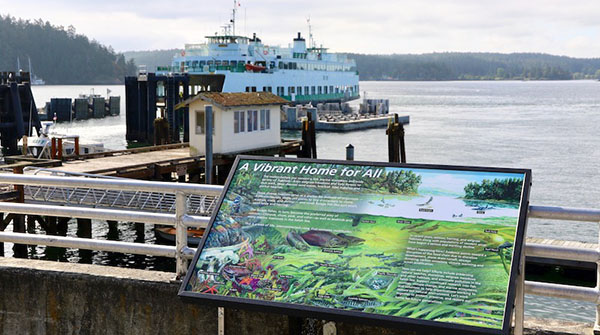
All photos courtesy of Tom Dichiara.
Those feelings were changed partly due to projects like the new ferry landing experience unveiled this weekend on Orcas Island, which includes a Marine Interpretive Overlook and a Coast Salish Mural. Three years in the making, the project team includes San Juan County and state officials, committee members, local artists, and Coast Salish tribal leaders and representatives. The county’s Marine Resources Committee provided their guidance on the site development, while Kendra Smith and Dr. Frances Robertson of the county’s Marine Environmental Resources team facilitated the project delivery with the help of both Public Works and Facilities crews.
Orcas-born Zackaraya Leck, a second-generation blacksmith, created the large-scale Kelp Forest and Crab in Eelgrass metal sculpture that lures one into the space and sets the stage for the new mural’s themes. The mural is entitled “Preservation” and was commissioned by the county, designed by Sarah Folden and completed with artists Brian Perry, Sam Barr, Erin Licata, and a few of their children, all of whom have Coast Salish ancestry, hailing from the Samish, Lummi, Cowlitz and Tulalip tribes. Designer Folden chose a mix of traditional Salish art and contemporary illustration for the mural to blend two worlds. The three canoes depicted in the mural each carry the name of an original village on Orcas. “The canoes were painted in silhouette because we did not want to tie them to any one era; they represent the past, present, and future inhabitants of the islands,” Folden explained.
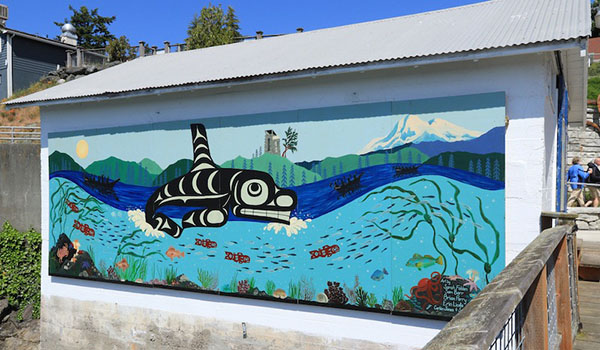
All photos courtesy of Tom Dichiara.
Around the corner from the mural, one can experience an interpretive bulletin board completed by Beth and Mark Gasser, and Carl Davis, and up the ramp from that is the overlook which provides a public viewing space with interpretive panels illustrated by Larry Eiffert. Combined, these items take viewers back in time and get us thinking forward, as well, to understand the Coast Salish First Peoples’ connection and importance to the islands and our interconnectedness with each other, the land, the sea, and all living creatures in the region. The overlook space is minimalist and meditative in its approach, thanks to sculptor Bruce Myers who completed the area with polished granite stones, sand textures and native plants, and paving murals. The polished boulders invite one to sit and dwell on the interconnectedness and the beauty of the Salish Sea while the tide ebbs and flows before you.
“When reminded of our sense of place we find direction, nature invites us,
by its very design to be part of that grand intelligence.” —Bruce Myers
According to Dr. Robertson, “We focused on art that would inspire our community and visitors to appreciate our marine waters, diverse lands, and the cultural heritage of the Islands.” Tribal leaders and elders were invited to bear witness to the unveiling. Krista Davies, who is Samish and the San Juan County Stormwater Engineering Technician, started the proceedings with a Coast Salish Acknowledgement created with Patti Gobin and Debra Lekanoff, our Washington State representative, frequent speaker with the Orcas Island Women’s Coalition, and member of the Tlingit tribe.
Lekanoff praised Gobin and council member Jamie Stephens’ leadership and expressed the larger picture for the crowd, “This is an incredible opportunity to acknowledge that the San Juan Islands are the heart of the Salish Sea and I am honored to go back to the legislature and say this is the way we honor the First Peoples. Like the First Peoples, your life on the islands is place-based. The work you see today is telling the story of this place and the Coast Salish, and your collaboration is important to ensuring the First Peoples do not lose their way of life, which is tied to the land and seas you all share.”
San Juan County Council member Jamie Stephens also welcomed the crowd, which was kept small due to COVID-19 protocols, and gave some of the history, explaining the space was repurposed from a former fueling station, adding that the project helped the county in other ways, including improving stormwater runoff.
Samish Rosie Cayou, a direct descendent of Louis Cayou—widely recognized as the first Anglo homesteader on Orcas Island—shared the stage with Gobin, calling upon their ancestors. Gobin highlighted the First People’s perspective that they are one with nature, “I descend from King Salmon and Cedar Trees,” is how she poetically stated it. In response, on an otherwise calm sea day, the crowd was struck with séance-like awe when, as if in acknowledgment to Gobin’s speaking to the ancestors, the waves literally crashed loudly against the rocks behind the crowd for a few dramatic moments before settling back to gently lapping at the shore.
Chairman Lawrence Solomon of the Lummi sang a traditional song and shared the significance of the Madrona tree seen on the new mural. Orcas Island is the home of their ancestors. They were the first people to fish, forage and live on its shores since time immemorial. They are also holders of The Great Flood story, which tells that their ancestors only survived The Great Flood by tying their canoes to a grand Madrona Tree. That Madrona tree is depicted on the mural on top of Mount Constitution, the highest point in the San Juan Islands.
Mural artist Folden hopes we will feel joy in the artwork, and the Marine Resource Committee hopes it is one of many collaborations that helps us steward the region responsibly. Judging from the response this weekend, they’ll both get their wishes. By reshaping the old unused space with art, nature, and intelligence, they have given us a way to reclaim a connection to the past, the land and the sea, and in the process, build community for a more collaborative and sustainable future.
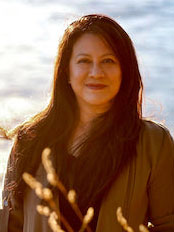
Ayn Gailey is the co-creator of Ōde, a multicultural author, and an islander. Her father is a descendent of the Karankawa, a now extinct tribe. www.ayngailey.com

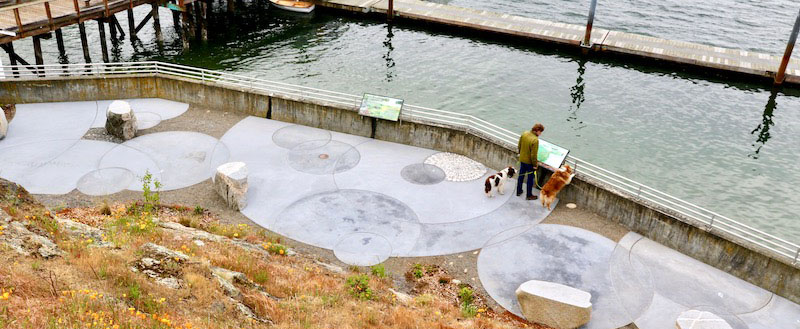

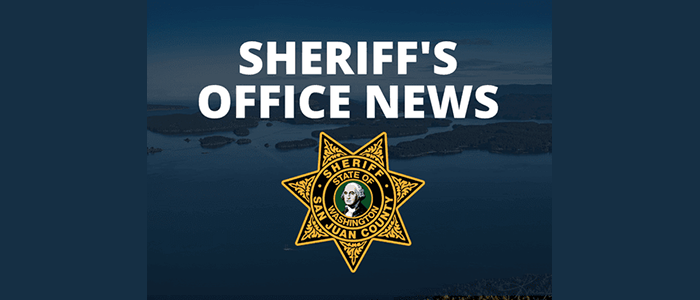
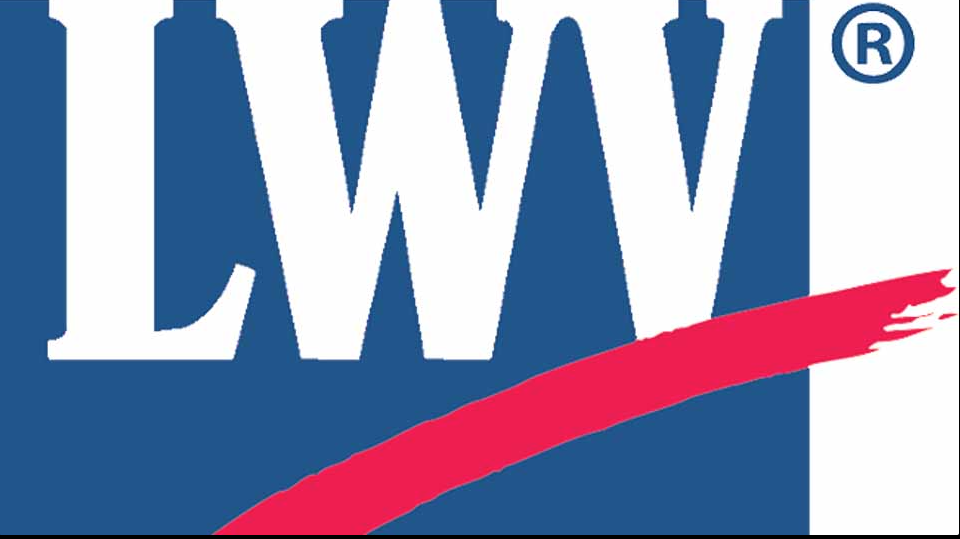
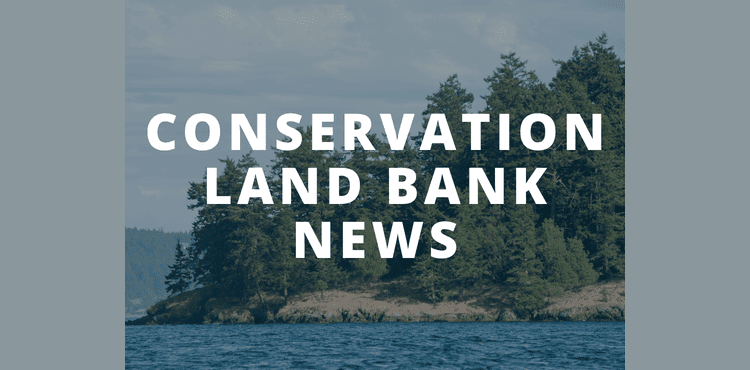



Thanks to all for the well-conceived effort. It will be a valuable, Informative display honoring our past and future sensibilities about caring for the lands and life of the San Juans.
Thank you to all the artists, volunteers, staff and Orcas islanders who helped bring this space and vision to reality. The overlook is really beautiful.
This is truly a beautiful honoring and blessing of the heart and soul of our beloved islands. Thank you to everyone who envisioned and created it!
After all the years of peeking at the end of “whatever that was down there” I read your piece and headed straight down to walk down and actually look properly! It is so beautifully coordinated, with the variety of experiences and levels. Thank you for your introduction!